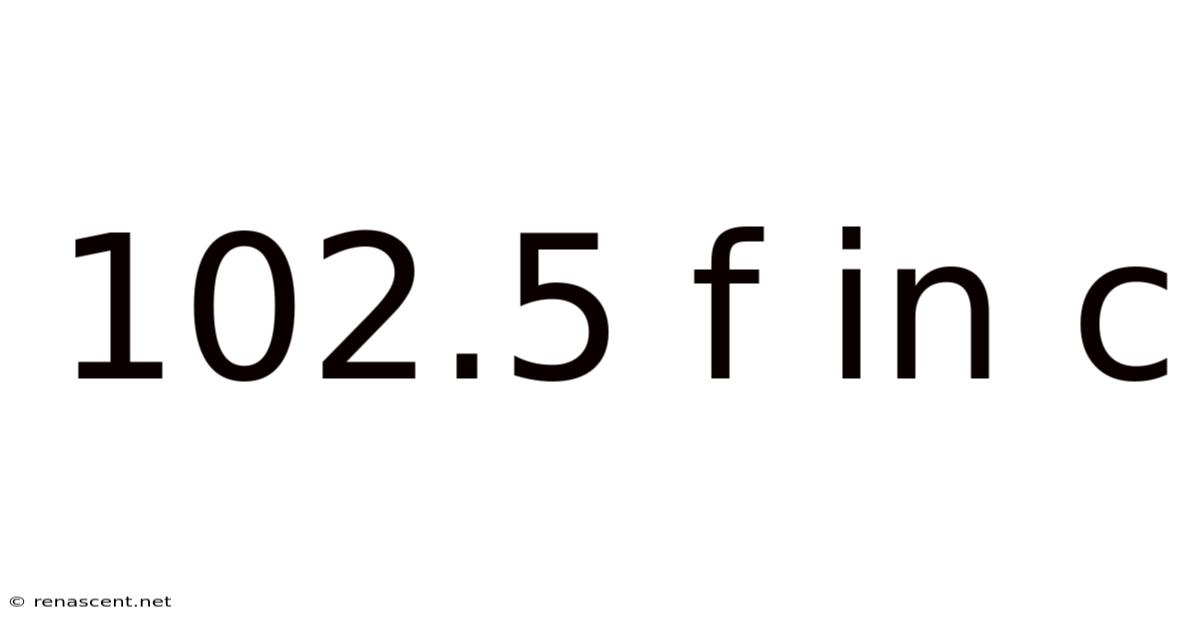102.5 F In C
renascent
Sep 20, 2025 · 5 min read

Table of Contents
Decoding 102.5°F: Understanding Fahrenheit, Celsius, and Temperature Conversions
Are you curious about what 102.5°F translates to in Celsius? This seemingly simple question opens the door to a deeper understanding of temperature scales, their history, and the crucial role they play in our daily lives and various scientific applications. This comprehensive guide will not only convert 102.5°F to Celsius but also delve into the mechanics of temperature conversion, explore the differences between Fahrenheit and Celsius, and address frequently asked questions about temperature scales. Understanding temperature is crucial in fields ranging from cooking and medicine to meteorology and engineering.
Understanding Fahrenheit and Celsius
Before we dive into the conversion, let's establish a foundational understanding of the two most commonly used temperature scales: Fahrenheit (°F) and Celsius (°C).
-
Fahrenheit (°F): Developed by Daniel Gabriel Fahrenheit in the early 18th century, the Fahrenheit scale is based on three reference points: the freezing point of a brine solution (0°F), the freezing point of water (32°F), and the average human body temperature (approximately 98.6°F). While widely used in the United States and a few other countries, it's less prevalent internationally.
-
Celsius (°C): Also known as the centigrade scale, Celsius was developed by Anders Celsius in the 18th century. This scale is defined by the freezing point of water (0°C) and the boiling point of water (100°C) at standard atmospheric pressure. It's the most widely used temperature scale globally and is the preferred scale for scientific applications.
Converting 102.5°F to Celsius
The formula for converting Fahrenheit to Celsius is:
°C = (°F - 32) × 5/9
Let's apply this formula to convert 102.5°F:
°C = (102.5 - 32) × 5/9
°C = 70.5 × 5/9
°C = 39.1666...
Therefore, 102.5°F is approximately 39.17°C.
This temperature falls within the range generally considered a fever in humans. It's crucial to remember that this is just a numerical conversion; the significance of this temperature depends heavily on context. In a medical setting, a temperature of 39.17°C would necessitate attention and likely medical intervention.
A Deeper Dive into Temperature Conversion
The conversion formula reflects the different scales' underlying structures. The factor of 5/9 represents the ratio of the degree intervals between the freezing and boiling points of water in the two scales. Subtracting 32 from the Fahrenheit temperature accounts for the difference in the freezing point of water between the two scales (32°F vs 0°C).
This seemingly simple calculation highlights the importance of understanding the underlying principles. Mistakes in converting temperatures can have significant consequences, especially in scientific research, engineering, and medical applications.
The Significance of 39.17°C (102.5°F)
A temperature of 39.17°C (102.5°F) is generally considered a high fever in humans. This elevated temperature indicates that the body is fighting an infection or illness. While a slight fever can be a beneficial part of the immune response, a temperature this high warrants medical attention. It's crucial to consult a healthcare professional if you or someone you know experiences a fever of this magnitude. Always seek professional medical advice for health concerns.
The significance of this temperature extends beyond human health. In various industrial processes, materials may exhibit different properties at this temperature, requiring careful monitoring and control.
Practical Applications of Temperature Conversion
The ability to accurately convert between Fahrenheit and Celsius is crucial in many fields:
- Medicine: Accurate temperature readings and conversions are essential for diagnosis and treatment.
- Cooking: Recipes may use different temperature scales, requiring conversion for accurate results.
- Meteorology: Weather reports often use both scales, depending on the region and audience.
- Engineering: Many engineering processes require precise temperature control, necessitating conversions between scales.
- Science: Scientific research relies on standardized units, often utilizing Celsius for temperature measurements.
Frequently Asked Questions (FAQ)
Q: Why are there different temperature scales?
A: Different temperature scales were developed independently at different times, using different reference points. The lack of a universally adopted scale early on led to the existence of multiple systems.
Q: Which temperature scale is more accurate?
A: Both scales are equally accurate in measuring temperature; they simply use different reference points and scales. The Celsius scale is more widely used in scientific contexts due to its simpler structure based on the properties of water.
Q: Are there other temperature scales besides Fahrenheit and Celsius?
A: Yes, there are other scales, including the Kelvin scale (used extensively in scientific applications), Rankine scale, and Réaumur scale. The Kelvin scale is an absolute temperature scale, meaning its zero point represents absolute zero—the theoretical absence of all thermal energy.
Q: How do I convert Celsius to Fahrenheit?
A: The formula for converting Celsius to Fahrenheit is: °F = (°C × 9/5) + 32
Conclusion
Understanding temperature conversions is a fundamental skill with applications across numerous fields. Converting 102.5°F to 39.17°C is more than a simple mathematical exercise; it illustrates the importance of understanding different measurement systems and their applications. While the conversion itself is straightforward, the context of the temperature—in this case, a high fever—highlights the significance of accurate measurement and the importance of seeking appropriate medical advice when necessary. Remember to always prioritize safety and consult relevant professionals when dealing with health-related issues or situations requiring precise temperature control. The knowledge gained from understanding temperature scales and conversions empowers you to navigate everyday situations and more complex scientific applications with greater confidence.
Latest Posts
Latest Posts
-
115 F In C
Sep 21, 2025
-
29 Divided By 3
Sep 21, 2025
-
Emission Spectra For Neon
Sep 21, 2025
-
Emptying The Recycle Bin
Sep 21, 2025
Related Post
Thank you for visiting our website which covers about 102.5 F In C . We hope the information provided has been useful to you. Feel free to contact us if you have any questions or need further assistance. See you next time and don't miss to bookmark.